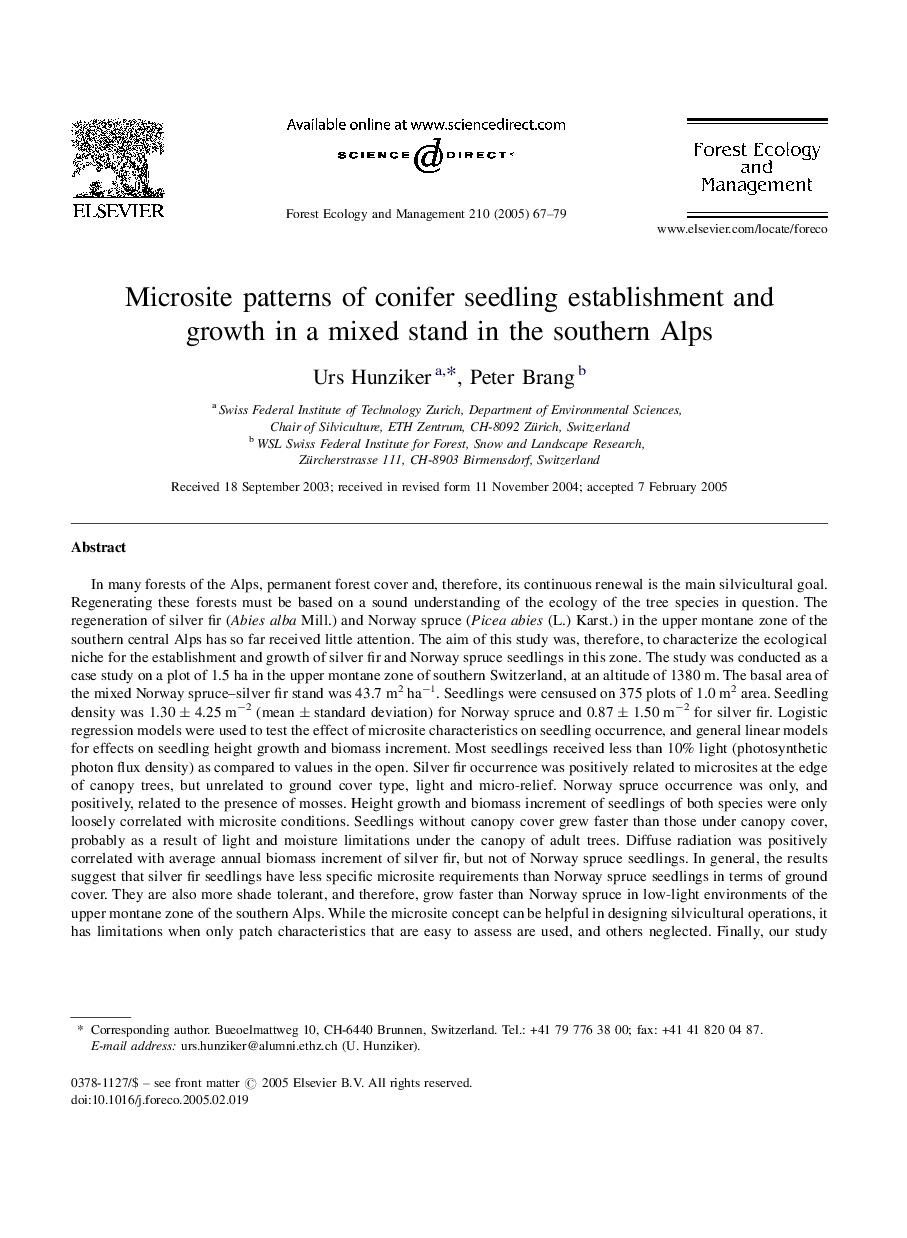| کد مقاله | کد نشریه | سال انتشار | مقاله انگلیسی | نسخه تمام متن |
|---|---|---|---|---|
| 9620355 | 159428 | 2005 | 13 صفحه PDF | دانلود رایگان |
عنوان انگلیسی مقاله ISI
Microsite patterns of conifer seedling establishment and growth in a mixed stand in the southern Alps
دانلود مقاله + سفارش ترجمه
دانلود مقاله ISI انگلیسی
رایگان برای ایرانیان
کلمات کلیدی
موضوعات مرتبط
علوم زیستی و بیوفناوری
علوم کشاورزی و بیولوژیک
بوم شناسی، تکامل، رفتار و سامانه شناسی
پیش نمایش صفحه اول مقاله

چکیده انگلیسی
In many forests of the Alps, permanent forest cover and, therefore, its continuous renewal is the main silvicultural goal. Regenerating these forests must be based on a sound understanding of the ecology of the tree species in question. The regeneration of silver fir (Abies alba Mill.) and Norway spruce (Picea abies (L.) Karst.) in the upper montane zone of the southern central Alps has so far received little attention. The aim of this study was, therefore, to characterize the ecological niche for the establishment and growth of silver fir and Norway spruce seedlings in this zone. The study was conducted as a case study on a plot of 1.5 ha in the upper montane zone of southern Switzerland, at an altitude of 1380 m. The basal area of the mixed Norway spruce-silver fir stand was 43.7 m2 haâ1. Seedlings were censused on 375 plots of 1.0 m2 area. Seedling density was 1.30 ± 4.25 mâ2 (mean ± standard deviation) for Norway spruce and 0.87 ± 1.50 mâ2 for silver fir. Logistic regression models were used to test the effect of microsite characteristics on seedling occurrence, and general linear models for effects on seedling height growth and biomass increment. Most seedlings received less than 10% light (photosynthetic photon flux density) as compared to values in the open. Silver fir occurrence was positively related to microsites at the edge of canopy trees, but unrelated to ground cover type, light and micro-relief. Norway spruce occurrence was only, and positively, related to the presence of mosses. Height growth and biomass increment of seedlings of both species were only loosely correlated with microsite conditions. Seedlings without canopy cover grew faster than those under canopy cover, probably as a result of light and moisture limitations under the canopy of adult trees. Diffuse radiation was positively correlated with average annual biomass increment of silver fir, but not of Norway spruce seedlings. In general, the results suggest that silver fir seedlings have less specific microsite requirements than Norway spruce seedlings in terms of ground cover. They are also more shade tolerant, and therefore, grow faster than Norway spruce in low-light environments of the upper montane zone of the southern Alps. While the microsite concept can be helpful in designing silvicultural operations, it has limitations when only patch characteristics that are easy to assess are used, and others neglected. Finally, our study suggests that counting the number of green shoots is a promising method to quickly and non-destructively estimate the biomass of a great number of small seedlings.
ناشر
Database: Elsevier - ScienceDirect (ساینس دایرکت)
Journal: Forest Ecology and Management - Volume 210, Issues 1â3, 16 May 2005, Pages 67-79
Journal: Forest Ecology and Management - Volume 210, Issues 1â3, 16 May 2005, Pages 67-79
نویسندگان
Urs Hunziker, Peter Brang,